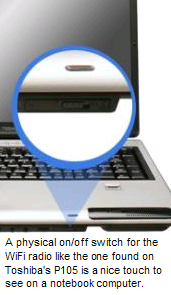Toshiba joins Vista system parade with four new notebooks


In order of appearance in the image gallery, the four notebooks are Toshiba's Satellite U205, Portege R400, Satellite P105, and the Satellite A135. According to the language that Toshiba supplied in its press releases for each of the notebooks, you can see how notebook companies struggle with the positioning of their notebooks. In the case of Toshiba, a notebook like the P105 may have features that will appeal to gamers that want to take their systems on the road. But at the same time, Toshiba offers a bit of "business positioning" in its language so as not to keep potential business buyers from the eliminating it or the other systems from consideration.
In some ways, it's understandable. I've long found the distinctions in computer positioning to be somewhat artificial. I've locked horns with vendors that find a way to refer to some current desktop offering as a workstation when everybody knows that it'll be slower than your basic PC a couple of years from now.
Whereas in the past, PC vendors have had the luxury of maintaining many brands and SKUs within them, each targeting very specific market segments, the Intel-based desktop, notebook and even server markets have become so commoditized (and the playing field largely leveled in other areas like manufacturing and supply-chain optimization) that the volume and razor thin margins can no longer support the marketing costs associated with too many brands, SKUs, and market channels.
Over time, I expect to see most system manufacturers move to simpler lineups where each system targets multiple segments. I think this phenomenon is already manifesting itself in the way Toshiba is positioning its systems. The only problem is that the language switches back and forth in ways that don't come right out and say, "this system should be as useful to a gamer as it is to a demanding multimedia production professional or someone working with CAD applications." Or maybe there's just some fickleness about the market that doesn't permit such dual positioning and honesty.
If, after reading about this bit about the clash of business and consumer positioning within the context of Toshiba's notebook offerings, you're feeling as though the notebooks don't deserve your attention, you may want to reconsider. As you'll see in our image gallery, each of the notebooks does indeed offer features that might appeal to you. For example, Toshiba clearly sticks to certain design principles in all of its notebooks (like physical on/off switches for its WiFi radios and manual volume controls versus software-based ones). I'd like to personally shake the hand of the engineer at Toshiba who insisted on these two features.
Toshiba also clearly feels strongly about fingerprint readers and biometric security (see photo, above left). Seeing systems with consumer positioning that feature biometric security is still pretty forward thinking as most consumers I know don't even bother password protecting their systems. They just want to power on and get on with things. But, biometric security in a consumer system is a good idea that consumers would be well-advised to take advantage of, if such a feature is present. Why? Well, it's not fool-proof. But it does raise the barrier to unauthorized access to systems with browsers that have users IDs and passwords so well cached that if someone with less than noble intent were to get into the system, they'd have carte blanche access to sensitive information and accounts. So, kudos to Toshiba for giving biometric security the attention it deserves.
Anyway, sometimes, it's the little touches that make the difference.